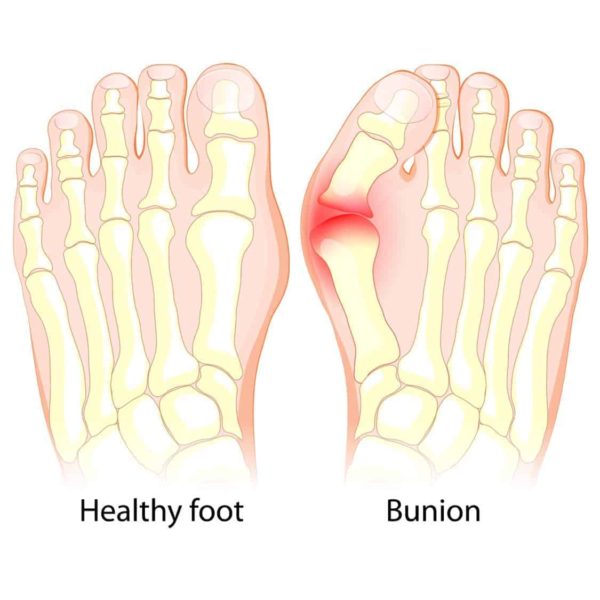
You’re not born with a bunion and it’s not in your genes, it’s born through your gait pattern, muscle pattern and how the foot is actually striking.
What is a bunion?
When the body reacts to improper foot strike and loading when moving, it causes more pressure on the big toe joint and it will eventually start to inflame the bursa sac by creating a swollen red cushion of bursal fluid at the friction point. In time, the cushion solidifies into a virtual rock, and the toes start curving. This can then start to ache and get painful, it might feel swollen or hot. Eventually the calcification starts to form and the big toe starts to move inward and creates the bunion. This ongoing process often hits the big toe the hardest, although the other toes can also be affected.
What causes bunions –
Bunions can be caused by –
1) Incorrect walking, muscle and foot strike pattern.
Your foot is supposed to strike the ground from the heel to mid foot and then push off on all 5 toes. Bunions start to form when you walk heel to rolling out onto the outside edge of the foot then pushing off with the big toe or the heel collapses inwards and then pushes off the big toe. The foot should be one of the most stable joints and the ankle should be one of the most mobile points.
2) Narrow, restrictive, cushioned and heeled shoes.
Our modern ‘normal’ everyday footwear are usually too narrow, so bunions are common in this scenario as we are trying to stuff our feet into a narrow shoe. Modern shoes are designed to look good but they are not functional. If you think about it, the widest part of the foot is the toes, therefore the widest part of the shoe should be at the toe box and if it’s not over time it is going to cause bunions, a deviated foot strike and uneven loading of the foot. Normal shoes including high heels can restrict the toes and this can affect the gait pattern.
3) Lack of crawling when you were a toddler (standing up too soon).
Where problems typically occur at the foot, it can start as young as the crawling stage, if a toddler doesn’t crawl enough, the proper primary hip muscles are not formed and this can change the way we walk. We tend to stick to the pattern that we created at a young age. As we age it becomes harder and harder to correct a walking pattern due to muscle memory we create over time.
4) Wearing shoes too early when you were a child.
Putting a shoe on at too early of an age can have an impact. There are 28 bones in the feet, our toes are meant to be able to spread, flex, and extend the foot. As we start to limit that function, certain parts of the foot and ankles can start to break down, the arches of the foot can collapse because it’s never built its strength.
How can we get rid of or prevent bunions?
There are different forms of treatments available for bunions. Addressing your posture will address how you move, this is an important first step when looking to address bunion issues. Changing your footwear to a flexible, non-cushioned, non-heeled, with a toe box wide enough for your toes to spread is also important but you need to make sure your feet are ready for the transition first. There is also the option of surgical bunion removal.
Bunion removal might be the best cause of action for some people; this will depend on the person’s age and how committed they would be to making changes to their posture/gait pattern. If you make the decision to have your bunions surgically removed, this may feel/look great to start off with but if you don’t resolve the actual issue causing the bunion then it may return.
Here are 3 exercises for you to try at home to help with bunions –
Make sure you subscribe to my Youtube channel @alignyourbodyTV to get more tips on how to improve your pain symptoms and improve your posture.



